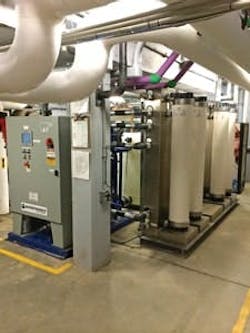About the author: Mike Warren is product manager - SkyHarvester for Watertronics. Warren can be reached at [email protected].
With the rise in popularity of using rainwater or storm water for non-potable applications, new uses for this water continue to pop up around the country, some in pretty unexpected places. While the two most popular uses of rainwater are irrigation and toilet flushing, zoological exhibits also are large consumers of non-potable water. When the award-winning Cincinnati Zoo & Botanical Garden started a parking lot renovation project, managing the runoff water from the parking lot and surrounding areas was a concern for the design team; using that water within the zoo was an ideal solution.
Initially, the idea of using the water for irrigation around the property was considered, but once the team looked at where water currently was being consumed, it quickly decided to use the water in other areas within the zoo. Until speaking with zoo officials, one might never guess how much water a polar bear takes with it when it gets out of the pool, or how much water is lost to evaporation on hot summer days from the moats around some exhibits. After consideration, the zoo was able to use the water from parking lot runoff in five major areas of the park: the polar bear pool, birdhouse irrigation, lion moat, cheetah moat, and African exhibit irrigation, with possible future expansion to flushing toilets in the zoo’s restaurant.
Each of these uses had varying water quality requirements, some of them never tried before. To develop the solution, Watertronics used a multi-step pump and filtration process to deliver the water at a 0.02-µ filtration level for all uses within the zoo.
A System for All End Uses
The first component of the water reuse system is located in a wet well next to a 300,000-gal storage tank located under the parking lot. A submersible pump pushes the water from the tank into the mechanical room and through a 100-µ automatic filter. After the water is filtered to 100 µ, it enters the ultrafiltration (UF) system, where it is filtered down to 0.02 µ—the virus level. For comparison, a human hair is 150 µ, and the naked eye cannot see anything smaller than 25 µ. UF systems like the one at the Cincinnati Zoo filter water to approximately 3,000 times smaller than a human hair.
After traveling through the UF system, the water is discharged into a clean water storage tank, where a booster pump station pressurizes it for distribution throughout the zoo.
As the systems around the zoo demand water from the pressurized mainline on the booster pump station discharge, the water level in the clean water storage tank drops. This causes the system to start the submersible transfer pump near the storage tank and the treatment system to process new clean water to refill the clean water storage tank. The entire system operates in real time, and can process water at a minimum of 60 gal per minute at 65 psi. Both the UF prefilter and the UF membrane filtration system have completely automatic backflushing, requiring minimal maintenance from the zoo staff.
The resultant water quality was exactly what the zoo was looking for. In this scenario, the quality of the water has multiple impacts for the property. For example, the water clarity in the polar bear pool is important because zoo visitors are looking through the water to view the animals. Water safety is important to humans and animals alike; filtering down to the virus level ensures safety for all.
Download: Here
